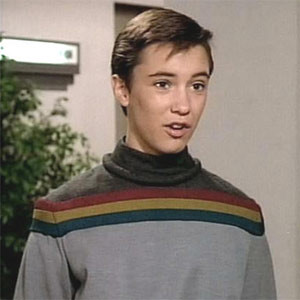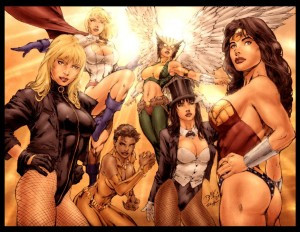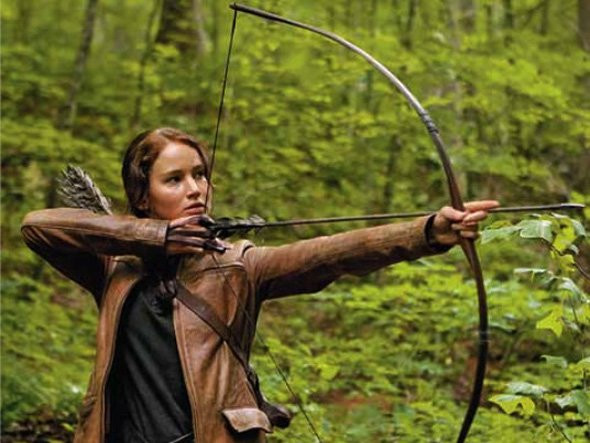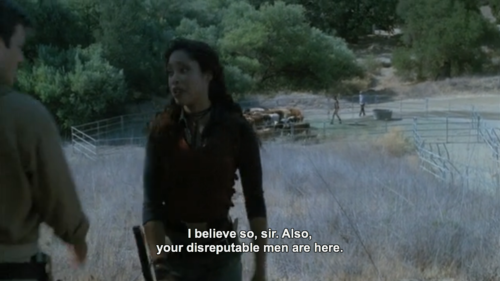In the Blog
Misogyny in Geek Culture
Seventh grade was the year I realized that I definitely Wasn’t Cool. Until that point, my relative coolness had been up for debate - sure, I was a brainiac know-it-all who spent most of her spare time with her nose stuck in a book, but I’d always done well socially and had a fairly sizeable group of friends.
Something happened, though, during that summer before seventh grade. Some kind of paradigm shift went down among the other girls in my class, and for whatever reason I totally didn’t get the memo. This memo outlined the fact that we would now wear tight jeans, listen to popular music, and, above all, we would Like Boys (because, hey, everyone is straight, right?). Meanwhile, I was still wearing pink sweatsuits printed with kittens, listening to my dad’s old alt-country LPs, and reading Babysitters Club books.
Oh, and I suddenly had bad skin. Like, really, really bad skin.
Seventh grade was like culture shock; more than anything, I felt as if I’d woken up in a new country, one where I didn’t understand the language or local customs, and had zero hope of ever leaving. I was stuck in teenager-land forever (or at least for the next eight years) and would just have to learn to adapt. The skin problems I had no control over, a new wardrobe was out of the question, popular music I was working on, but liking boys - now that was something I could do. And how.
Boys in my class were out of the question, so it would have to be someone famous. I somehow knew that I wasn’t cool enough to like one of those Tiger Beat boys the rest of the girls in my class swooned over; it would have to be someone more nerdier, more obscure.
One weekend my friend and her dad introduced me to Star Trek. Here was a world I could get behind: acne was a thing of the past, no one seemed to have any racial or socio-economic factors affecting their relationships, and you could order whatever food you wanted from a magic box on the wall and then have it immediately appear right in front of you. Oh, and there was a cute teenage boy.
I was hooked.
That Monday I went to school and proudly wrote a note to another girl in my class.
I have a crush on someone, it said.
Her reply was quickly handed back to me: Who?
Wil Wheaton, I wrote, drawing little hearts around his name.

Total dreamboat.
My answer was, of course, intercepted. By the end of the school day I’d become even more of a social pariah than before, which wasn’t something I’d thought possible.
1995 was not a good time to be a geeky girl.
2012, however, is a different story.
It has, arguably, never been a better time to be a geek. Geek chic is all the rage: black-rimmed glasses and graphic t-shirts with obscure or nerdy references have entered mainstream fashion, and sleek, technical accessories like smart phones and tablets are everywhere. Movies, television shows and books with science fiction or fantasy themes are becoming increasingly popular, and video games and comic books are no longer widely considered to be the domain of prepubescent boys. Oh, and Wil Wheaton? Is totally cool now and everyone loves him. Even my mom (one of the least geeky people I know) calls me every time he’s on The Big Bang Theory to tell me how great he is.
The age of geek culture has arrived.
Although still largely the bastion of straight white men, the rise of geek culture means that we’ve seen it diversify at an exponential rate. Pretty great, right? Unfortunately, the representation of women, people of colour, people with disabilities, and queer and trans folk within geek culture is limited, often bordering on nonexistent. Even worse, many people seem to be wilfully blind to examples of racism, sexism, ableism, homophobia and transphobia in geek media, and prefer instead to celebrate what they perceive to be geek culture’s superiority to pop culture.
Women are still woefully underrepresented in science fiction and fantasy. Queer, trans, racialized and disabled people find even less representation in geek media, and when they do, they’re often depicted in sexist, racist, homophobic and transphobic ways, exotified and tokenized for what’s perceived to be a largely straight, white, male audience. See, for example, Raj Koothrappali from The Big Bang Theory - an incredibly racist portrayal of an Indian man. First of all, Raj does not speak for much of the show, due to his severe anxiety around women; this means that his straight, white, male friends do the majority of the talking for him (a seriously problematic dynamic). Not only that, but he’s often referred to as a “foreigner” - at one point, Sheldon Cooper even straight-up calls him, “the foreigner who tries to understand our culture and fails”. Finally, Raj’s cultural background is often the punchline of the joke; his “funny” accent, badly stereotyped family and “backwards” customs are frequently held up for the audience’s amusement.
Another good example is Guinan, Whoopi Goldberg’s character in Star Trek: The Next Generation. Guinan, a mysterious alien who comes from a species of “listeners” and frequently offers advice and counsel to other characters, and can be summed up pretty neatly by Wikipedia’s definition of the incredibly racist Magical Negro trope:
The Magical Negro, or magical black friend, is a supporting stock character in American cinema who is portrayed coming to the aid of a film’s white protagonists. These characters, who often possess special insight or mystical powers, have been a long tradition in American fiction.
Or how about Cho Chang, Harry Potter’s sometime crush and first kiss? The racism and exotification here are subtler, but still present: Chang, who belongs to Ravenclaw, the Hogwarts house that values intelligence highly, is frequently described throughout the books as thin, light-skinned and smart, all of which are exotified Asian stereotypes. Not only that, but Chang is basically a blank slate onto whom Harry projects his fantasies; she barely has any dialogue with him, and what little she does say does almost nothing to give depth to her character. And finally, there are her names, both of which begin with the Ch- sound, which is a racist stereotype of how white westerners hear Asian languages (think about how people describe Chinese languages as sounding like “ching chong” or something similar).
Straight, white women fare slightly better in geek media, but not by much. Let’s take a look at their representation a few currently popular geek movies and television shows:
Inception, which has a main cast of eleven characters, has two women in it.
The Dark Knight Rises, with a main cast of ten, also has two women in it.
The Hobbit film series, the first of which will premiere later this year, has a main cast of forty two with, you guessed it, two women.
Game of Thrones fares slightly better, with a principal cast of thirty, eight of whom are women.
By and large, does geek culture know or care about these imbalances? No, not really. This is how geek culture tends to view itself:

Top: Snooki from Jersey Shore, Bella Swan, Kim Kardashian, Kat Von D, and Lady Gaga. Captioned as: ?Pop Culture?. Bottom: Aeryn Sun from Farscape, Zoë Alleyne Washburne from Firefly, Susan Ivanova from Babylon 5, Jadzia Dax from Star Trek: Deep Space 9, and Samantha Carter from Stargate. Captioned as: Geek Culture. The main caption reads: ?Female Role Models: Fuck Barbie. I?m Buying My Daughter a Ray-Gun?
This meme was making the rounds a few months ago, and I saw a disappointingly large number of my friends sharing it on Facebook. It’s problematic for many reasons (slut-shaming, equating being fully-clothed with being a good role model, and the fact that it plays right in to our society’s love of setting women against each other), but the worst of it is that this isn’t even the way the majority of women in geek culture are represented.
Here’s the thing: I love geek culture. I’m all for celebrating it, and the strong female characters that have come out of it. But we also need to be honest with ourselves about what geek culture is really like. The sad fact is that the images below are a more accurate representation of how women are typically depicted in geek media:

Even if we wished that this was the norm for women in geek culture:


Media aside, many women feel unwelcome and unwillingly sexualized when they try to participate in geek culture. My younger sister is an avid World of Warcraft player and is often asked to “prove” that she’s female (i.e. send lewd pictures of herself), and has had to fend off unwelcome advances from male players more than once. Women are often accused of only participating in geeky activities in order to get men - see, for instance, this piece by Tara Tiger Brown, subtly titled “Dear Fake Geek Girls: Please Go Away.” In her post, Brown complains about” pretentious females who have labeled themselves as a ‘geek girl’ [and have] figured out that guys will pay a lot of attention to them if they proclaim they are reading comics or playing video games.”
Really? I mean really? We’re trotting out this old trope now? If Brown is so concerned about the geekiness of certain girls of her acquaintance, then maybe she should help them explore their geeky side rather than deciding than shunning them for being man-hunters.
If the reaction of geeky women who feel threatened by other women is bad, then the reaction of men in geek culture who feel threatened is even worse. Witness what happened with Anita Sarkeesian, whose Kickstarter campaign to fund a project that would examine gender tropes in video games received a deluge of negative comments, including threats of death and rape towards Ms. Sarkeesian (and what happened to Shameless guest blogger Stephanie Guthrie when she called out the creator of the game).
Let’s get a couple of things straight here:
Straight White Dudes, we are not here to steal geek culture away from you - we’re here to help make it MORE AWESOME.
Excluding people just because they’re not geeky enough, or bullying them because they’re female is just as bad as the isolation and bullying you may have experienced while growing up. If, as a geeky teenager, you hated and resented the kids who picked on you, why the hell would you turn around and do it to someone else?
One last thing: we also need to stop putting down so-called pop culture and admit that much of geek culture is pop culture. This is a good thing, not a bad thing, because it means that we can help shape the messages that are sent by the media to all those impressionable young folk. That’s right: we can use our old nemesis, pop culture, to make more geeks.
I am hopeful that we can also use this influence to help smart, ass-kicking women and trans people, people of colour, queer and disabled people become the rule in media, rather than the exception. But first, before we’re able to start affecting change outside of geek culture, we need to admit to ourselves that a lot has to change within geek culture in the ways that we depict these groups. Because feminism and equality, much like charity, begin at home.
Anne Theriault lives in Toronto with her husband and young son. She spends her days teaching yoga, reading in cafes, and trying to figure out how to negotiate in toddler-ese. It’s a good life.



